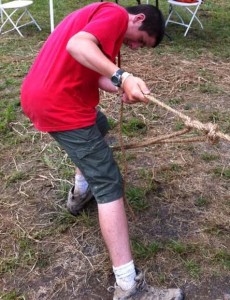 A rope tackle is applied where the guylines meet the anchors for a wide range of pioneering projects. A rope tackle is effective when you want to pull more than your own strength will permit. The idea behind a rope tackle is similar to that of a tackle using blocks and pulleys. In a rope tackle, one end of the rope has to be anchored around a spar or tied through a ring or other piece of hardware that doesn’t move. Then a loop knot is tied along the standing part of the rope forming a fixed loop that acts as the wheel in a block. A butterfly knot is often the knot of choice for this job. It can be tied in the standing part of the rope and is both easy to tie and fairly easy to untie even after being put under a strain.
A rope tackle is applied where the guylines meet the anchors for a wide range of pioneering projects. A rope tackle is effective when you want to pull more than your own strength will permit. The idea behind a rope tackle is similar to that of a tackle using blocks and pulleys. In a rope tackle, one end of the rope has to be anchored around a spar or tied through a ring or other piece of hardware that doesn’t move. Then a loop knot is tied along the standing part of the rope forming a fixed loop that acts as the wheel in a block. A butterfly knot is often the knot of choice for this job. It can be tied in the standing part of the rope and is both easy to tie and fairly easy to untie even after being put under a strain.
1) Start with a butterfly knot in the desired position along the standing part of the rope.
2) When there is lots of line, make a bight in the running end and feed it through the butterfly knot’s fixed loop.
3) To tighten the line, grab a hold of the bight and pull it towards the anchor.
4) When the desired tension is put on the line, with one hand, keep the line taut, and holding the bight in the other hand, use the bight to form a half hitch around both tight lines.
5) As the half hitch is secured, maintain the tension on the line by pinching the standing part, making sure it doesn’t slip.
6) Still maintaining the tension on the tightened lines in the standing part, cinch the half hitch up close to the fixed loop of the butterfly knot.
As an added measure, tie another half hitch around the tightened lines. All excess rope should be coiled under the knots.
PIONEERING — USES
- To adjust the strain on the guylines of a pioneering project or a flagpole
- To adjust the tension on the foot and hand ropes of a monkey bridge
- To tie down and secure your equipment on a trailer or truck
- To hoist or lower equipment
- To tighten hold-down ropes on large tents and flies

